The latest revision of the choker, displaying a multi-color fade/wipe animation.
The first revision of the choker, displaying a simple back-and-forth animation.
This project consists of three parts:
- outshine, an Arduino program that displays animations on a NeoPixel strand
- OutshineApp, an Android app to communicate with an Arduino running Outshine via USB serial
- the rave choker, the physical device that I built which runs Outshine firmware
Link to this section Motivation
Link to this section Outshine
Outshine itself was based on some work I did for NU Rover, Northeastern University's team which competes in the Mars Society's University Rover Challenge. On the rover, LEDs are controlled by an ATmega328PB separate from the primary STM32 microcontroller. As such, to implement the NeoPixel handling, I essentially had free reign over this chip.
Functionally, the rover is required to display different colors to indicate its control mode (teleoperated or autonomous) and status about its autonomous navigation. It does not need to show animations, but I included them anyway because I figured they could be useful for displaying more detailed status information.
Link to this section Rave Choker
I got a ticket to a Rezz show, and I wanted to incorporate some flashy LEDs in my outfit somehow. Rezz is known for her LED glasses which display a spiral pattern. I wanted to create something similarly colorful and animated, but not a direct reimplementation of the glasses.
The process started with me standing in front of a mirror and holding a lit LED strip up to different parts of my body. Eventually, I settled on a choker, because I liked the look of it the best.
Originally, I had intended for the choker to be controlled via Wi-Fi by broadcasting its own network and exposing a server with a web UI. I had some familiarity with this architecture, as it's similar to how I built the wall matrix project.
At the time, I had recently bought a limited-edition pink RP2040 Feather board from Adafruit, and I really wanted to use it for a project. This board doesn't have Wi-Fi or Bluetooth, so I figured I would add an additional Pi Zero to handle the networking.
With the added bulk of another board in mind, I decided to explore putting the boards and battery off of my neck and into a hat.
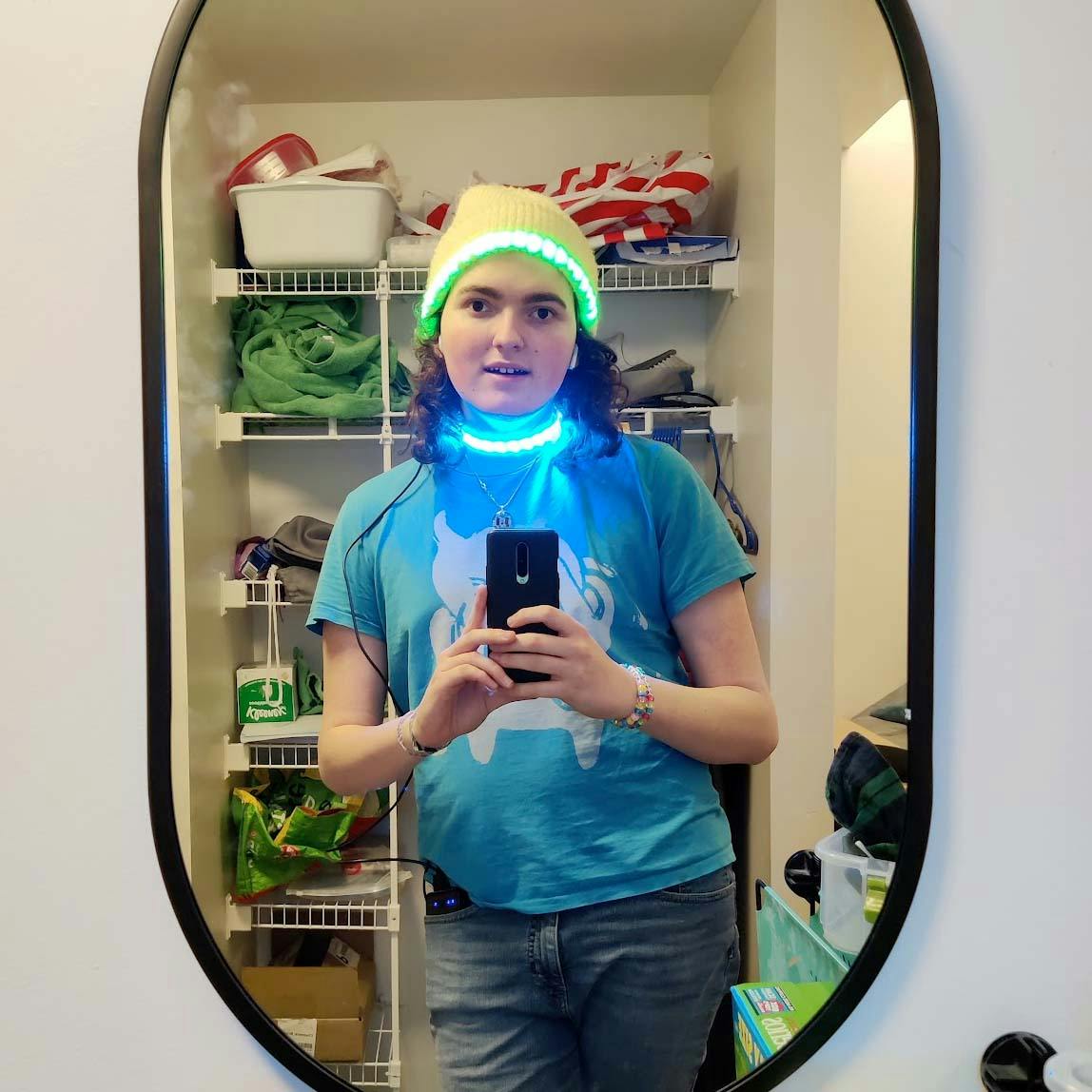
This worked to some extent, but the stretchiness of the hat didn't pair well with the fragile ribbon of the LED strip. In the end, I ditched the idea as I thought it seemed too fragile for extended use.
Link to this section OutshineApp
Going back to the drawing board, I decided to try leaving the Feather board on my neck and directly attaching it to my phone over USB. The phone would interface with the board over serial and provide power to it (removing the need for a dedicated battery).
I tried to use the WebSerial API for this, but was hit with a really stupid issue involving Chrome on Android:
As such, I switched to a native app. I built it in React Native, because I already had some familiarity with React.
Link to this section Redesign
Tragically, this first revision of the choker was left slightly trampled after I went a little too hard in a food house moshpit. I was able to quickly repair the broken solder joints, and the LED strip was barely damaged (somehow only the red channel of the last pixel was broken), but I still realized that I needed to rethink the design.
I had the following goals in mind for the redesign:
- Remove the need for a tether between the phone and the choker (as this could get dangerous in a crowd, or yanking it could cause the choker to come off of me)
- Make the clasp at the back of the choker more sturdy
- Remove the silicone outer layer from the LEDs
Link to this section Technical Description
Link to this section Outshine
The Outshine firmware takes in commands over I2C, UART, or Bluetooth. Initially, commands were four bytes long:
[1 byte] Red channel[1 byte] Green channel[1 byte] Blue channel[1 byte] Animation command
Later, I reworked the protocol to use a two-byte indicator before each byte, to prevent the ends of the protocol from getting out of sync:
01: Start Transaction, remaining 6 bits are the animation ID10: Color data, next 6 bits are a portion of an RGB color- Color data is shifted in by this command, so any existing color data will be shifted left by 6 bits
11: Final color data, next 6 bits are color data and this is the end of an RGB color- This can be followed by either additional colors (
10) or the end of the transaction (00)
- This can be followed by either additional colors (
00: End Transaction
I2C support was added for Rover, UART support was added for debugging the Rover but was later used for the rave choker, and Bluetooth support was added for the V2 choker.
The driver relies on one of two libraries, depending on the architecture:
- Adafruit_NeoPixel for ATmega Arduino boards
- Adafruit_NeoPXL8 for the RP2040, to take advantage of the chip's PIO capabilities
The code makes use of a table of function pointers to control the active animation. The animation state (e.g. current active pixel in a wipe animation, current frame in a fade animation) is persisted across a shared struct to make transitions between animations more smooth.
Link to this section OutshineApp
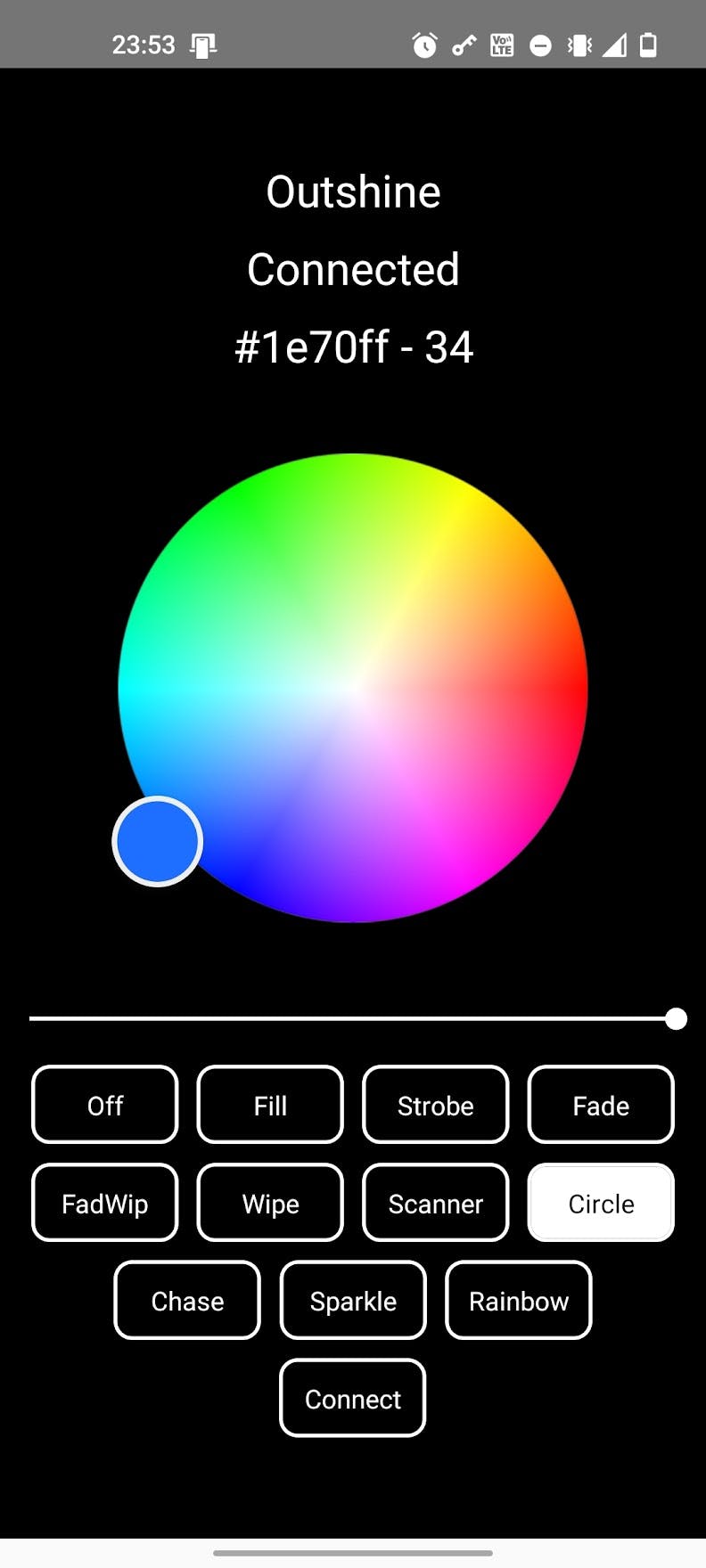
The app is built in React Native, using react-native-serialport to handle the USB serial communication and react-native-ble-plx to handle Bluetooth. I'm just using off-the-shelf components for the color wheel, buttons, and brightness slider. I didn't even bother to build a production version; I just keep the development .apk on my phone.

The V2 version of the app switched to simple color swatches and added support for multi-color configurations (complete with some pride-themed presets). This was much easier for me to manipulate quickly.
Link to this section Rave Choker
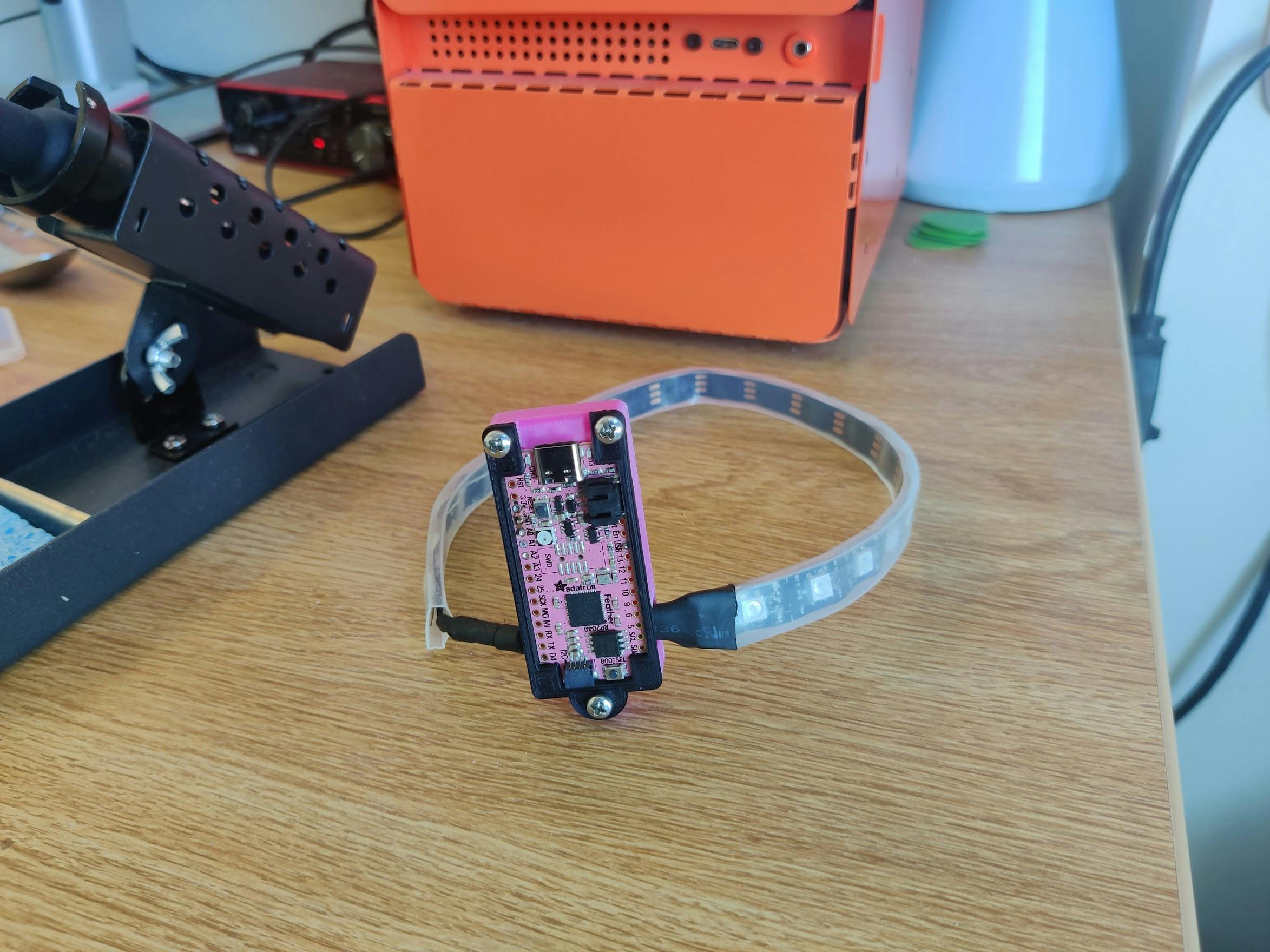
The V1 rave choker itself consisted of a strand of NeoPixels connected to an Adafruit Pink RP2040 Feather. I used a "banana connector" as a clasp. It was wired to ground on both sides, so it wasn't electrically functional.

The body of the choker was housed in a 3D-printed case, made from two parts that screw together using threaded inserts. The case has an open top to show off the pink RP2040, because I thought it looked cool.
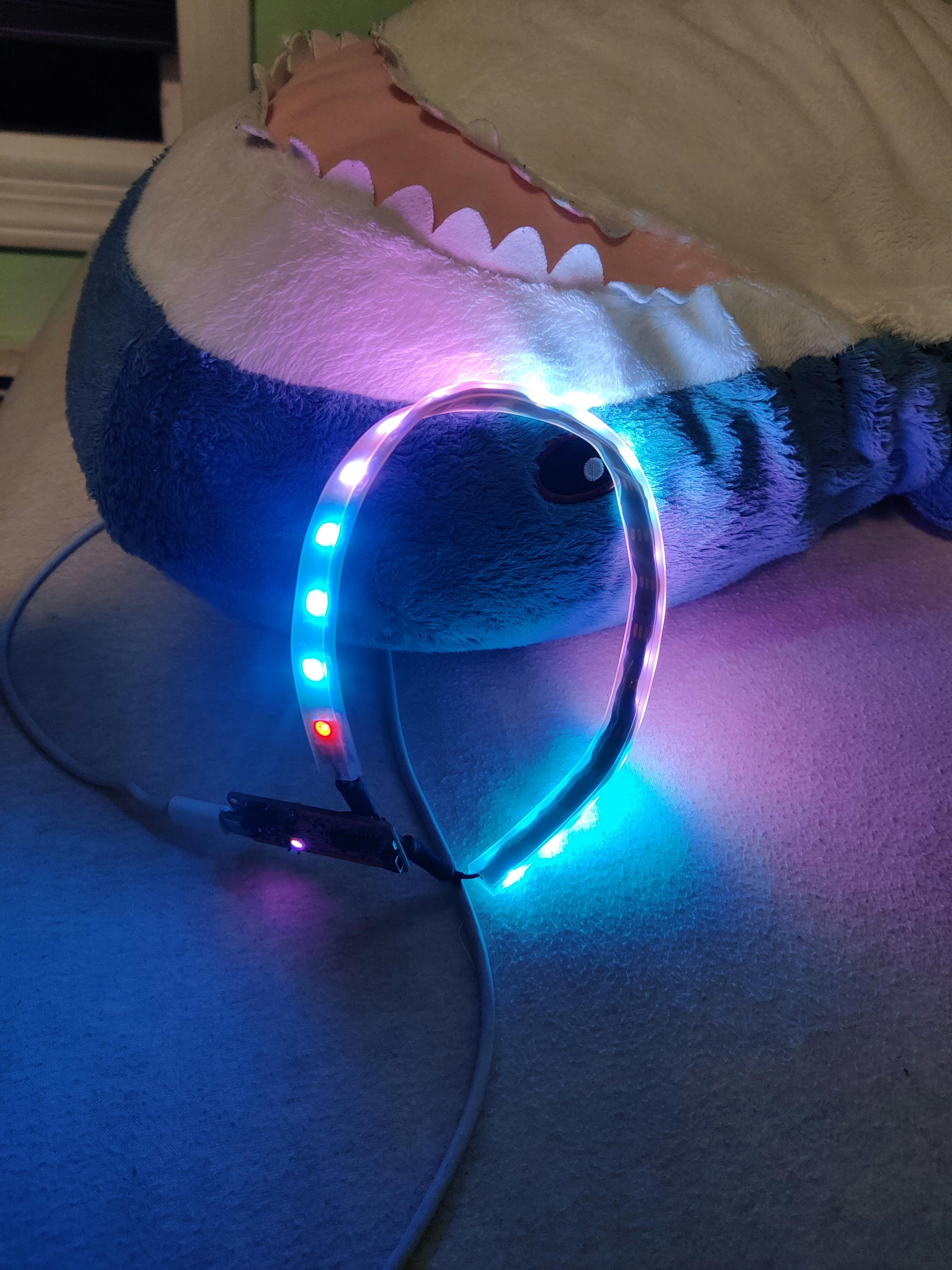
The V2 rave choker also uses a 3D-printed frame, but it completely encloses the board. This frame also includes a battery, allowing for operation without a tether. I continued to use a Feather, but I opted for the nRF52840 variant for Bluetooth support.
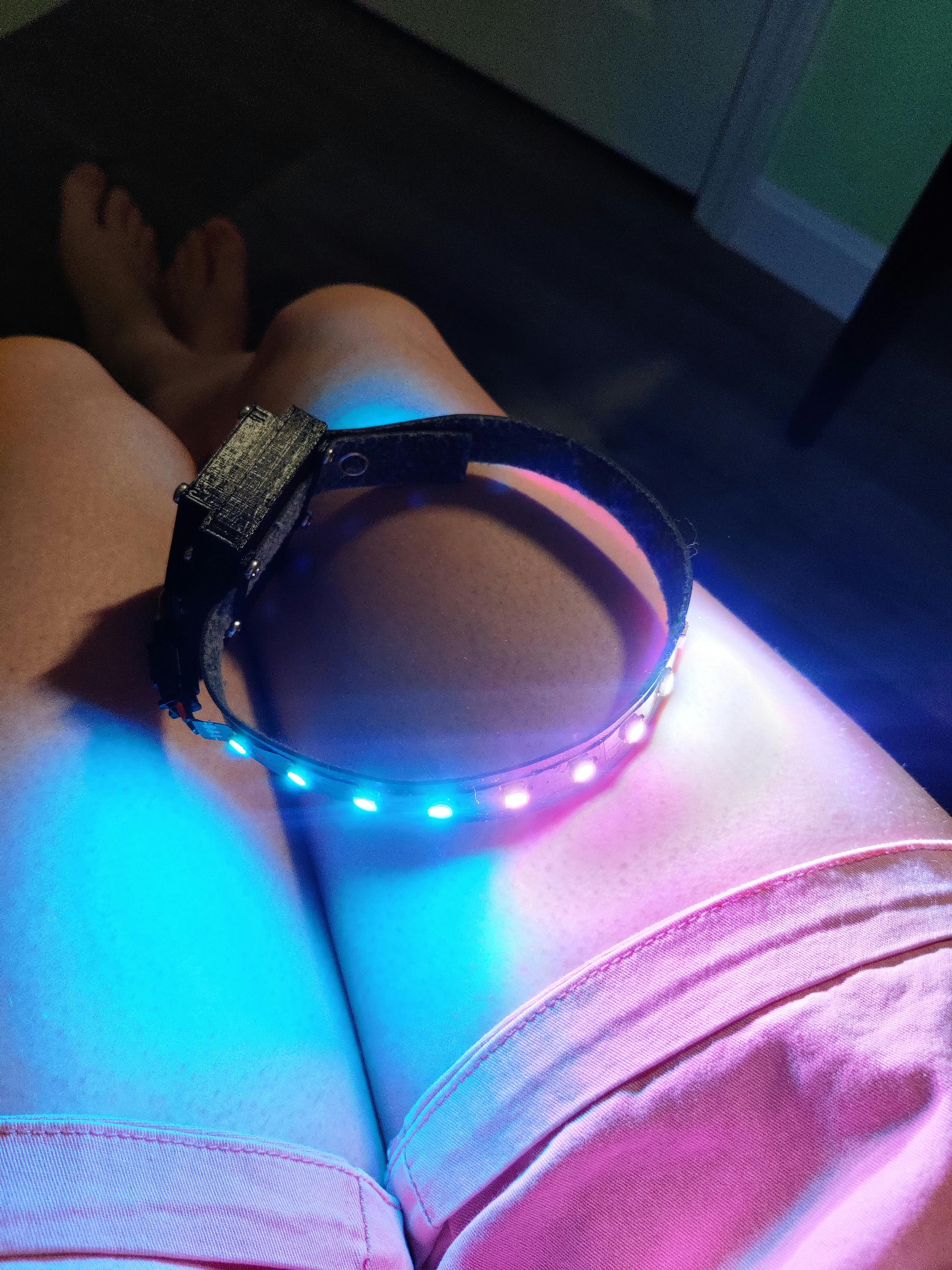
I used fake leather material and metal snaps to provide the structure of the choker, and I attached the NeoPixels to the material using E6000 adhesive, loosely following this guide for a harness bra from Adafruit. I again blacked out the copper contacts on the front of the LED strip, but this time, I used black nail polish instead of eyeliner. The result vaguely resembles a studded look, and the choker doesn't look out of place even with the lights turned off.

Link to this section Results
It worked well at the Rezz show! In fact, a cute transfem noticed it, and we ended up talking and dancing together for most of the night :)
I had initially been worried about the battery life being an issue, but as long as the LEDs aren't solidly on full-white, it doesn't seem to be a huge problem.
I was also a bit worried about the "crowd-safety" of it--what if someone yanks on the cord?--but it came unplugged easily without yanking on my neck.
I also wore the choker to GAY BASH'D, a combination DJ set and drag show. I made a few revisions to the setup prior to this event, adding a brightness slider to OutshineApp and the 3D-printed case to the choker itself.
After getting the Bluetooth version up and running, I also wore the choker to Carpenter Brut and SVDDEN DEATH shows, both of which had much more intense moshing than shows I had been to in the past. That said, the choker held up well! It seems to have some level of beer-spill-resistance, which is essential.
Overall, I think I really achieved the goal I started with. The choker is something flashy, stylish, and uniquely "me," and it stands out in the perfect way among a crowd at an EDM show. Also, the Outshine project will undoubtedly prove a useful starting point for future experimentation with NeoPixels.
Starting off with a tethered solution wasn't ideal (for instance, it made going through security a bit of a hassle). Even though the tether wasn't too much of a hassle at more chill shows, it still was much more convenient to have a Bluetooth-based design.
It's also a bit cumbersome to change the animation, requiring me to unlock my phone and open the app. I only really wanted to change it every few songs, but it was still frustrating to have to stop raving to fiddle with a smartphone app. Physical controls would help remedy this, at the cost of more complexity. At the end of the day, I think the tradeoffs I made paid off.
